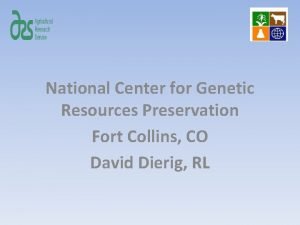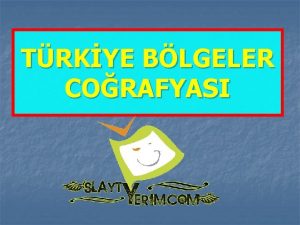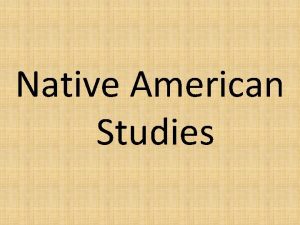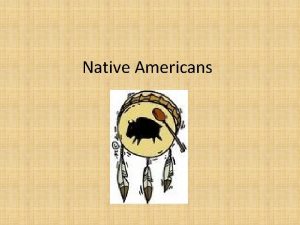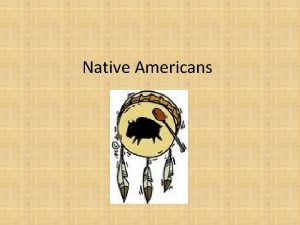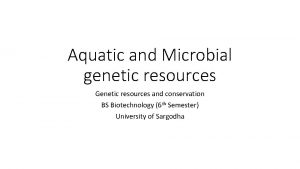STATUS OF NATIVE ANIMAL GENETIC RESOURCES IN TRKYE












- Slides: 12

STATUS OF NATIVE ANIMAL GENETIC RESOURCES IN TÜRKİYE Prof. Dr. M. İHSAN SOYSAL Prof. Dr. Muhittin ÖZDER TRAKYA UNIVERSITY TEKİRDAĞ FACULTY OF AGRICULTURE DEPARTMENT OF ANIMAL SCIENCE misoysal@ttnet. tr mozder@tu. tzf. edu. tr

PREPARATION OF THE FIRST REPORT ON THE STATE OF THE WORLD'S ANIMAL GENETIC RESOURCES REGIONAL CAPACITY BUILDING TRAINING WORKSHOP ON THE CONSERVATION AND MANAGEMENT OF ANIMAL GENETIC RESOURCES, 10, 11, 12 MAY, 2004, TEKİRDAĞ, TÜRKİYE & REGIONAL CONSULTATION ON PRIORITY ISSUES IN SUSTAINABLE USE AND CONSERVATION OF ANIMAL GENETIC RESOURCES, 13 MAY, 2004, TEKİRDAĞ, TÜRKİYE DÜNYA HAYVAN GENETİK KAYNAKLARININ DURUMU ÜZERİNE BİRİNCİ RAPOR HAZIRLIĞI ÇALIŞMALARI HAYVAN GENETİK KAYNAKLARININ YÖNETİM VE KORUNMASI ÜZERİNE BÖLGESEL KAPASİTE OLUŞTURMA ÇALIŞTAYI 10, 11, 12 MAYIS 2004, TEKİRDAĞ & HAYVAN GENETİK KAYNAKLARININ SÜRDÜRÜLEBİLİR KULLANIM VE KORUNMASI İLE İLGİLİ ÖNCELİKLİ KONULAR ÜZERİNE BÖLGESEL DANIŞMA TOPLANTISI 13 MAYIS 2004, TEKİRDAĞ

Recently (10 -14 May 2004) a regional workshop has been organized by FAO in Turkiye including 17 countries from Balkan peninsula, Central Asia and Near and Middle East. In Tekirdağ (Turkiye) under thema of preparation of the first report on the state of World's Animal Genetic Resources. This topics include two seperate meeting first meeting was about the regional capacity building training workshop on the conservation and management of Animal Genetic Resources. The second meeting covered the regional consultation on priority issues in sustainable ust and conservation of animal genetic resources. The breeds are subjected to the program of genetic preservation studies are Eastern Anotolian, Red Cattle in Erzurum , Angora Rabbit ( Poultry Research Ins. in Ankara) , natıve silk worm lines of Bursa region ( Silk Worm Research Institute in Bursa) , native poultry breed of Turkey , Sakız, Dağlıc, İvesi, Karacabey Merino, Kıvırcık, Karayaka, İmroz sheep breeds ( Bandırma Research Ins. ), Red Karaman sheep breeds are preserved in Eastern Anotolian Research Inst. in Erzurum. According to the World Watch List for domestic animal diversity ( Scherf B. D. , 2001). Ten cattle breeds, two horse breeds and three sheep breeds are extincted. The most important reason for extinction is eross breeding with exotic breeds ( economic reasons).


PREPARATION OF THE FIRST REPORT ON THE STATE OF THE WORLD'S ANIMAL GENETIC RESOURCES REGIONAL CAPACITY BUILDING TRAINING WORKSHOP ON THE CONSERVATION AND MANAGEMENT OF ANIMAL GENETIC RESOURCES, 10, 11, 12 MAY, 2004, TEKİRDAĞ, TÜRKİYE & REGIONAL CONSULTATION ON PRIORITY ISSUES IN SUSTAINABLE USE AND CONSERVATION OF ANIMAL GENETIC RESOURCES, 13 MAY, 2004, TEKİRDAĞ, TÜRKİYE A picture showing a statute of Deer found in King tombs from Alacahöyük it was used as rite accessories of Hatti priest in rituel ceremony.

PREPARATION OF THE FIRST REPORT ON THE STATE OF THE WORLD'S ANIMAL GENETIC RESOURCES REGIONAL CAPACITY BUILDING TRAINING WORKSHOP ON THE CONSERVATION AND MANAGEMENT OF ANIMAL GENETIC RESOURCES, 10, 11, 12 MAY, 2004, TEKİRDAĞ, TÜRKİYE & REGIONAL CONSULTATION ON PRIORITY ISSUES IN SUSTAINABLE USE AND CONSERVATION OF ANIMAL GENETIC RESOURCES, 13 MAY, 2004, TEKİRDAĞ, TÜRKİYE A picture showing a symbol of goblet from sire rite used to present and serve wine to the Hatti Gots from Norbert Schimmel collections.

According to the same source Malakan horse breed and Cine capari sheep breeds are in endangered state ( as breeds at risk ). During last three years the remaining eight breeds of sheep (Kıvırcık, Karayaka, İmroz, Dağlıç, Akkaraman, Morkaraman, İvesi) , one goat breed ( Angora Goat) and four cattle breeds ( Gray Cattle, Native Black Cattle, eastern Anotolian Red Cattle, Southern eastern Anatolian Cattle, Red Cattle) are subjected heavy pressure of crossbreding from economic point of wiew. To pull attaction to this problem two university based database were constructed. One is called native farm animals genetics sources (http: //genkaynaklari. sitemynet. com) established department of animal science of Tekirdağ Agricultura Faculty of Trakya University by Prof. Dr. M. İhsan Soysal for all farm animal species. One data based from Middle East Technical University by Prof. Dr. İnci Togan for only sheep breeds (http: //togan 3. bio. metu. edu. tr/turkey. html. ) as the form of database of sheep breed of Turkey. The General Directorate of Agricultural Research has also recently constructed the national data base of farm animals (http: //www. tagem. gov. tr). As a results of cersus , surveys scientific papers the risk status of breeds can be assesed and priority decission could be taken.

Red Cattle, Southern eastern Anatolian Cattle, Red Cattle) are subjected heavy pressure of crossbreding from economic point of view. To pull attaction to this problem two university based database were constructed. One is called native farm animals genetics sources (http: //genkaynaklari. sitemynet. com) established department of animal science of Tekirdağ Agricultural Faculty of Trakya University by Prof. Dr. M. İhsan Soysal for all farm animal species. One data based from Middle East Technical University by Prof. Dr. İnci Togan for only sheep breeds (http: //togan 3. bio. metu. edu. tr/turkey. html) as the form of database of sheep breed of Turkey. The General Directorate of Agricultural Research has also recently constructed the national data base of farm animals (http: //www. tagem. gov. tr). As a results of cersus , surveys scientific papers the risk status of breeds can be assesed and priority decission could be taken.

Türkiye has a great potential for animal production and the topographic and climatic conditions are favorable for animal husbandry in general. Even though Türkiye is among the leading countries in the nımbers of some of the livestock , the animal productivity sometimes can be quite low due to the high numbers of low producing , umimproved native animals. Nevertheles , the adaption capacity of these indigenous animals , to the local conditions is higher than cultural breeds. Native farm animal genetic resourches constıtute an important resource in total number of farm animal population. Production systems in Türkiye vary from chances in international and national agricultural policies and in the milk and beef markets had greatest effect to the production systems and changing the content of population from native breeds to the exotic breeds. The unsufficient productivity of native breeds resoned the declining trend of the native farm animals in total animal population. Breeds of low economic values were investigated in the begining of the republican period and shoved that the selection would be ineffective to obtain the production values same as exotic breeds.

NATIVE SHEEP BREEDS IN TÜRKİYE White Karaman Red Karaman Awassi Karayaka Daglıc Sakiz Name of breed (in Eng. ) White Karaman Red Karaman Awassi Karayaka Daglic Sakiz Local Name of Breed Akkaraman Mor Karaman İvesi Karayaka Dağlıç Sakız Origin of Breed Indigenous breed in Turkey Anatolia In South West Asia Indigenous breed in Turkey Originated from the Greek island of Chios around 1830 Purpose of Raising Combined 1)food: meat 2)fibre: wool 3)food: milk Combined 1) fibre: wool 2) food: meat 3)food: milk Combined 1)fibre: wool 2)food: meat 3)food: milk Main Region or country Central Anatolia Eastern and north-eastern part of Turkey South-eastern of Turkey Northern Anatolia Western Anatolia İzmir province, Western Turkey Features Small head, long legs, fat tailed Fat tailed. Tail with three lobe of shape Near- east fat tail type, roman nose, long and dropping ears. Long thin tailed. Small body size. Short fat tailed Long tail fat at base Color White with black nose and occasionally around eyes. Red, Brown. From reddish brown to black White with brown head and legs. Occasionally black or brown Usually white with black eyes, head and legs. White with black spots on head and legs. White with black spots around mouth eyes, ears, legs. Polled or not Most of ram has horn, ewes without horn Most of ram has horn, ewes usually without horn Most of ram has spiral horn, ewes usually without horn Most of ram has a thick, strong, spirally horn, ewes usually without horn Most of ram has spiral horn, ewes usually without horn Ewes usually without horn. Ram has a strong and spiral horn. Herd (%) 46. 8 (%) 19. 6 (%) 1. 6 (%) 3 (%) 15. 5 (%) 0. 02 (%) Height (♀, ♂ cm) ♂=62 - 67 cm ♀= 63 – 66 cm ♂=65 - 71 cm ♀= 66 – 68 cm ♂=70 - 80 cm ♀= 60 – 70 cm ♂=60 - 64 cm ♀= 60 – 62 cm ♂=60 - 67 cm ♀= 58 – 62 cm ♂=76 - 81 cm ♀= 70 – 76 cm Body Weight (♀, ♂ kg) ♂=50 - 60 kg ♀= 35 – 40 kg ♂=60 - 70 kg ♀= 45 – 50 kg ♂=60 - 90 kg ♀= 30 – 50 kg ♂=40 - 50 kg ♀= 35 – 40 kg ♂=50 - 60 kg ♀= 35– 40 kg Lactation Lenght 150 days 141 -150 days 200 days 130 – 140 days 140 – 179 days 230 days Birth Weight 4 kg 3 -4 kg 4. 3 – 4. 5 kg 2. 5 – 4. 0 kg 3. 4 – 3. 5 kg ---- Fleece Weight 1. 5 – 2. 0 kg 32’S – 36’S 1. 5 – 2. 0 kg 28’S – 32’S 1. 8 – 2. 4 kg 36’S - 40’S 2 – 2. 5 kg 28’S – 32’S 1. 8 – 2. 5 kg 36’S – 50’S 1. 5 – 2. 5 kg 50’S – 56’S Twinning rate 4 -5 % 4 -8 % 6 -10 % 4– 8% 1 -2 % Over of 70 % Birth Rate 85 -90 % 85 -87 % 80 -85 % 85 – 90 % 80 – 90 % --- Milk (kg) 40 – 60 kg 50 -65 kg 90 -155 kg 40 – 45 kg 40 – 50 kg 200 – 230 kg Tail (kg) Fat tailed (5 -6 kg) Fat tailed Fat tail type Long thin tailed Short fat tail Long fat tailed Other Remarks This breed produces a good wool quality. This breed are well adapted to herd climate The breed is well adapted to hot climate The breed is well adapted to wood and rainy climate This breed are well adapted to step climate The breed is well adapted to cool down climate Combined 1) food: milk 1)food: meat 2)fibre: wool Combined 1)food: milk 2) fibre: wool 3)food: meat

NATIVE SHEEP BREEDS IN TÜRKİYE (CONTINUE) Western Thrace Çine Çapari Name of breed (in Eng. ) Western Thrace Çine Çapari Local Name of Breed Kıvırcık Çine Çapari Origin of Breed Indigenous breed in Turkey --- Purpose of Raising Combined 1)food: Meat 2)fibre: wool 3)food: milk Combined (milk, meat, wool) Main Region or country North-western of Turkey Aydın province in Turkey Features Thin tail, short ears, middle weighed breed Color Gokceada Hemşin Herik Tushin Hemsin Herik Tıshin Gökçeada Hemşin Herik Tuj Island Zackal type ---- Similar To Dağlıç ---- Combined 1)fibre: wool 2)food: meat 3)food: milk Combined Wool, milk, meat Gökçeada island Çanakkale province Artvin and Ardahan Province. North Eastern of Turkey Amasya Province Northern Anatolia Eastern of Anatolia (Kars, Ardahan and Iğdır provinces) White colour One of the smallest breeds of Turkey, long thin tailed Long tail fat at base Short fat tail, small body Short and fat tailed White, sometimes with spotted face also black on brown. White colour and sometimes have light brown to dark black spots on the feed and stomach White with black spots around eyes, nose, ears and legs Black, brown, white White with dark spots on head. White Polled or not Ewes without horn, rams has a horn. ---- Most of ram has spiral horn, ewes usually without horn Most of ram has horn, ewes usually without horn ---- Herd (%) 7. 5 (%) ---- ---- Height (♀, ♂ cm) ♂=67 - 71 cm ♀= 60 – 66 cm ---- ♂=60 - 65 cm ♀= 60 – 62 cm ---- Body Weight (♀, ♂ kg) ♂=40 - 45 kg ♀= 30 – 40 kg 38 kg ♂=40 kg ♀= 38 kg (35 – 40 kg) ---- Lactation Lenght 120 -180 days ---- 157 – 200 days ---- Birth Weight 3. 9 – 4. 3 kg ---- 3. 7 – 4. 0 kg ---- Fleece Weight 1. 5 – 2. 0 kg 44’S – 56’S ---- 1. 6 – 2. 0 kg ---- 1. 5 – 2. 0 kg ---- Twinning rate 10 – 20 % ---- 15 – 20 % ---- Birth Rate 82 -90 % ---- ---- Milk (kg) 60 – 90 kg ---- 70 – 100 kg ---- 20 -25 kg ---- Tail (kg) Long thin tailed ---- Short fat tailed ---- Other Remarks The breed is well adapted to cool down climate. ---- The breed is well adapted to cool climate ----- Gokceada Combined 1)food: milk 2)food: meat 3)fibre: wool

NATIVE BREED AND TYPE OF CATTLES IN TÜRKİYE BREED &TYPE CRITICAL MAINTANANCE YERLİ KARA X BOZ IRK X DOĞU ANADOLU KIRMIZISI X KİLİS SIĞIRI X KULTAK SIĞIRI X ZAVOT X HALEP SIĞIRI X ÇUKUROVA SIĞIRI X DÖRTYOL SIĞIRI X KIRIM (LEH) SIĞIRI X KIBRIS SIĞIRI X SEFERİHİSAR SIĞIRI X KAFKASYA SIĞIRI X MALAKAN SIĞIRI X DİYARBAKIR SIĞIRI X KARACADAĞ SIĞIRI X URGA SIĞIRI X SİYAH (KALMUK) SIĞIR X ELEŞKİRT SIĞIRI X KARAİSALI SIĞIRI X
 Trkye
Trkye Genetic drift vs gene flow
Genetic drift vs gene flow Genetic programming vs genetic algorithm
Genetic programming vs genetic algorithm Genetic programming vs genetic algorithm
Genetic programming vs genetic algorithm A gene pool consists of
A gene pool consists of Gene flow vs genetic drift
Gene flow vs genetic drift National center for genetic resources preservation
National center for genetic resources preservation Operation transformation process
Operation transformation process Difference between fixed and variable resources
Difference between fixed and variable resources Renewable vs nonrenewable resources worksheet
Renewable vs nonrenewable resources worksheet Venn diagram of organelles in plant and animal cells
Venn diagram of organelles in plant and animal cells Venn diagram for plant and animal cells
Venn diagram for plant and animal cells Animal rights versus animal welfare
Animal rights versus animal welfare






